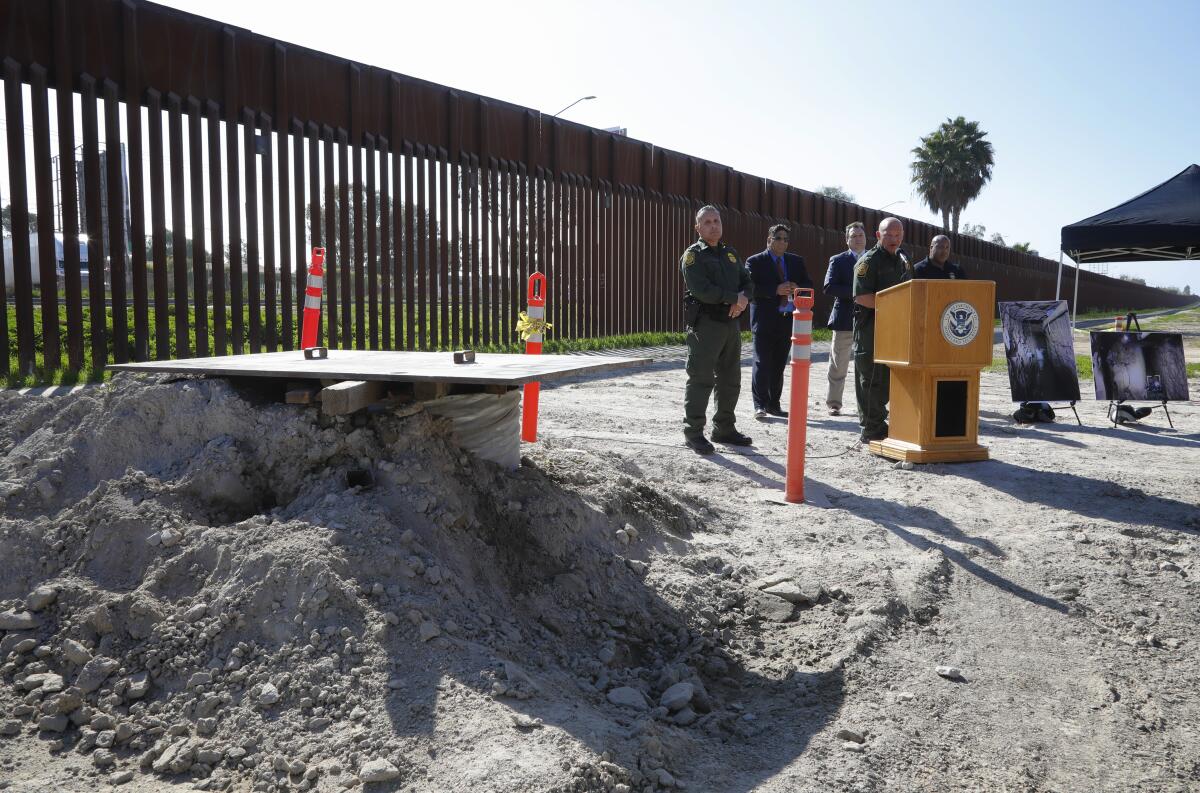Authorities in San Diego unearth longest cross-border drug tunnel in history

- Share via
SAN DIEGO — Authorities announced Wednesday the discovery of the longest cross-border drug tunnel in history, stretching nearly one mile from the Tijuana airport into the United States.
U.S. Border Patrol agents described the tunnel as the “most sophisticated they had seen,” with an extensive rail-and-cart system to rapidly transport drugs, forced-air ventilation and high-voltage electrical cables and panels. The tunnel, named Baja Metro by border agents, also had an elevator at its entrance and a complex drainage system.
The drug tunnel’s discovery was the culmination of a “challenging” multiyear, multi-agency investigation led by a coalition of U.S. law enforcement officers, according to the Border Patrol.
That investigation began in the United States then crossed into Mexico, where the entrance to the tunnel was discovered in August near the northeastern corner of Tijuana International Airport.
Members of the San Diego Tunnel Task Force then began to map Baja Metro by dropping down into it and trying to follow it, which led agents back into the U.S., investigators said.
Border Patrol Agent Lance LeNoir described the taxing conditions and time it took to map out the 4,309-foot tunnel.
“I may have left parts of my soul down in that tunnel,” he said lightly.
The conditions included limited oxygen, standing water and tight spaces that forced agents to crouch down under the tunnel’s 5½-foot ceiling to explore and investigate the tunnel’s path, only 2 feet wide.

Authorities would not disclose the exact location of the tunnel’s near-exit into the U.S. but showed journalists an access point they drilled into the tunnel — 70 feet beneath the ground — at a secure spot between the primary and secondary border barriers in the San Diego neighborhood of Otay Mesa.
Though no arrests or drug seizures have been made in connection with the discovery, U.S. authorities stressed they believe it was active and in operation at one point, partly because it split into two directions.
“At the time of the discovery, the tunnel did not reach the surface into the United States, but evidence strongly suggests that tunnel was previously operational,” said Deputy Chief Border Patrol Agent Aaron Heitke.
Heitke said that toward the end of the main tunnel, agents discovered more than 100 sandbags and piles of dirt that blocked the suspected former exit of the tunnel. He said an offshoot from the main tunnel stretched about 3,529 feet into the U.S.
John Callery, special agent in charge with the Drug Enforcement Administration, said the level of sophistication of Baja Metro was indicative of the determination and monetary resources of Mexican drug cartels.
“The tunnel discovery is another drastic reminder of how serious the drug problem is and how the cartels will take risks and expend endless amounts of money to get deadly drugs like fentanyl and methamphetamine into the United States,” Callery said.
Citing the ongoing investigation, authorities would not say which criminal drug trafficking organization they suspect to be responsible for the tunnel’s engineering.
“By working together, the agencies of the Tunnel Task Force have prevented Mexican cartels from using this tunnel to get additional drugs into our communities and ultimately destroying the lives of our families,” Callery said.
Agents also declined to say what prompted the investigation, which was a joint effort by the Border Patrol, Homeland Security Investigations, the DEA and the U.S. attorney’s office. Mexican law enforcement authorities also helped with the investigation, agents said.
Investigators said they used intelligence sources and technology at the onset of the criminal inquiry. They declined to comment on what specific technology was used.
It was the 72nd drug tunnel discovered since 1993 in the San Diego area, where the clay soil is particularly good for supporting tunnels but not so rocky that digging is too much of a challenge, agents said.
The second-longest tunnel into the U.S. was discovered in 2014 in Otay Mesa and was 2,966 feet long.
Investigators said they were not exactly sure how many years Baja Metro had been there.
LeNoir, who did the majority of the tunnel mapping, said he is always surprised by the capabilities of the criminal organizations that engineer the tunnels.
“Just when we think they wouldn’t be capable, they’re going into an area where we never really thought they had the capacity to go,” he said.
“I would bet, yes, that right now they are building more tunnels,” LeNoir added.
More to Read
Sign up for Essential California
The most important California stories and recommendations in your inbox every morning.
You may occasionally receive promotional content from the Los Angeles Times.














